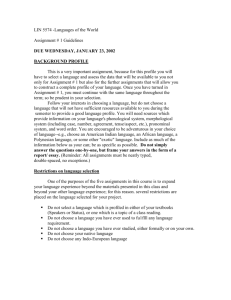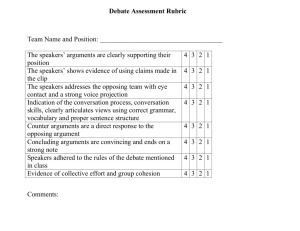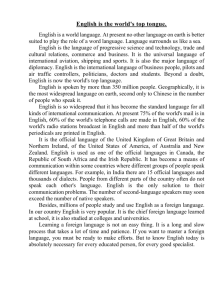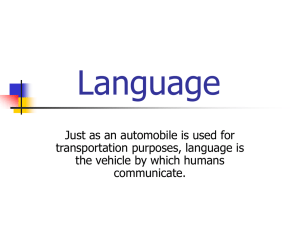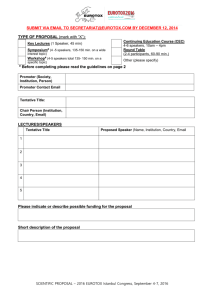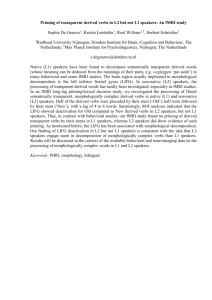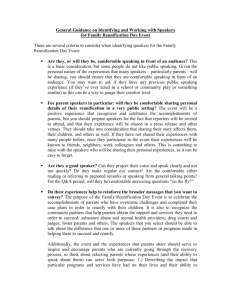Week 3: Language
advertisement
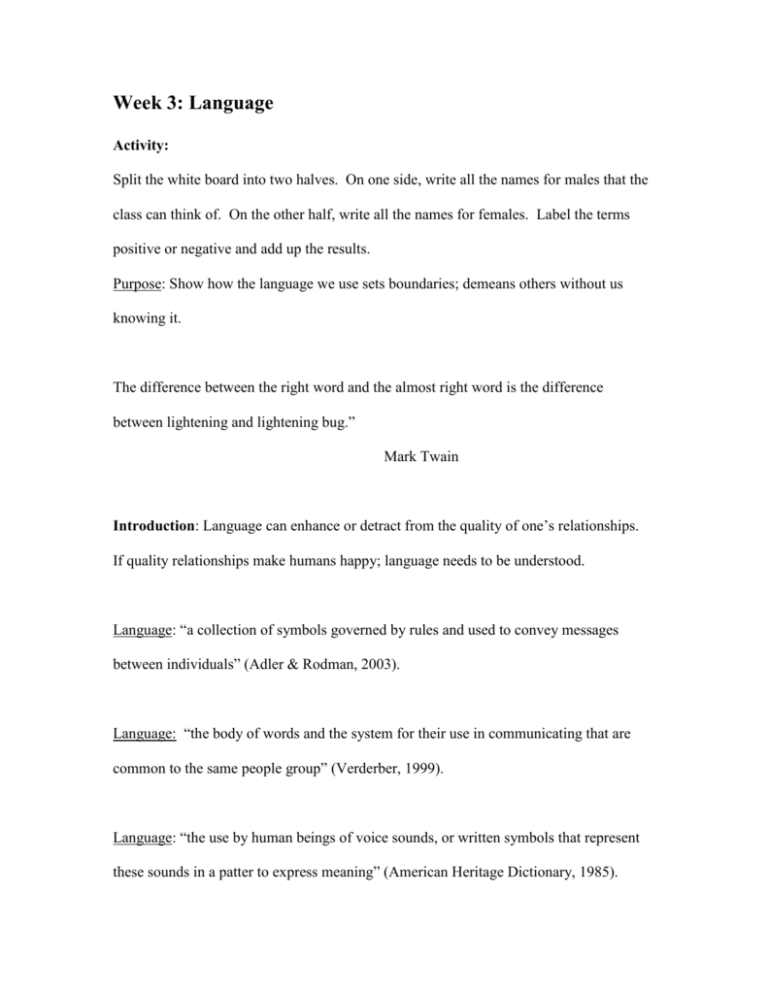
Week 3: Language Activity: Split the white board into two halves. On one side, write all the names for males that the class can think of. On the other half, write all the names for females. Label the terms positive or negative and add up the results. Purpose: Show how the language we use sets boundaries; demeans others without us knowing it. The difference between the right word and the almost right word is the difference between lightening and lightening bug.” Mark Twain Introduction: Language can enhance or detract from the quality of one’s relationships. If quality relationships make humans happy; language needs to be understood. Language: “a collection of symbols governed by rules and used to convey messages between individuals” (Adler & Rodman, 2003). Language: “the body of words and the system for their use in communicating that are common to the same people group” (Verderber, 1999). Language: “the use by human beings of voice sounds, or written symbols that represent these sounds in a patter to express meaning” (American Heritage Dictionary, 1985). Components: 1. Language is symbolic “Arbitrary construction that represent a communicator’s thoughts.” Example: LOVE (on the white board) “A rose by any other name would smell just as sweet.” What if a rose was named a mushpot? Would that change its smell? 2. Meaning is not in language, but people Successful communication occurs when we negotiate the meaning of a statement. Example: Use of the word PIMP now compares to 50 years ago. SHOW CLIP FROM TOMBSTONE 3. You choose language Based on patterns and history. Language is Rule-Governed: (agreed upon rules) 1. Phonological rules: given how words sound when pronounced. Example: champagne, lead, tear, read 2. Syntactic rules: Structure of language 3. Semantic rules: meaning of specific words What makes man = male/biologically; women = female biologically 4. Pragmatic: governs how we use language Two examples: 1. Connotative: conveys feelings; subjective 2. Denotative: conveys content; literal meaning; objective Language is Powerful Shapes Attitudes: (can be used to promote or demote) Sexist/racist language is real; it does affect people Example: Congalton’s use of “humyn” vs. human Reflects Attitudes: -Power -The need to achieve content goals and relational goals Women use more hedges and hesitations that men to show submissiveness. They don’t want to be a “feminazi” or a “bitch.” But when men are blunt, they are confident. Women in power positions need to be especially careful. Affiliation: convergence vs. divergence Language can put one in the ingroup or outgroup. Attraction and Interest Responsibility: You vs. I messages (conflict resolutions situations) -Taking ownership of feelings rather than evaluating others. Example: “You are not doing this right” vs. “I must not be explaining this very well.” Troublesome language: semantic problems (we don’t understand properly) Equivocal language: more than one correct definition Relative words: gain meaning by comparison Slang: used by a group of people whose members belong to a similar co-group Example: “hawked down,” “Quan”---Football and my ingroup Jargon: specialized vocabulary that functions as a shorthand by people of a common background. Example: I know what a “tight eagle cover 2 shell” is. Not many other people do. I know what “Gun Deuce Hop 56 Berretta, Y-drag” means. Allness statements: words that reflect unqualified, often untrue, generalizations that deny individual differences or variations. Example: Everyone likes that. They all do that. Disruptive Language Fact vs. Opinion Fact vs. Inference: conclusions derived from interpreting evidence Emotive language: words that announce a speaker’s attitudes toward something. Example: How people often speak of the O.J. Simpson case; or now, the Michael Jackson case. Evasive Language: Euphemism: pleasant term substituted for an unpleasant one Example: Fat vs Big-boned Equivocation: a deliberately vague statement that can be inferred either way. Profanity and vulgarity: indicates a lack of vocabulary Gender and Language Men and women differ in their content: Men and women talk about different topics. Reasons for communicating: Men often communicate for a purpose (utility/practical) Women often communicative to develop relationships. Culture and Language Low context culture: uses language primarily to express thoughts, feelings and ideas as clearly and logically as possible. Example: United States, Canada High context culture: values language as a way to maintain social harmony Example: Many Asian and Middle Eastern countries Language and Worldview Linguistic determinism: “The world-view of a culture is shaped b the language its members speak.” Linguistic relativity: If language determines thought, the speakers of different language will experience the world differently. Both are components of the Sapir-Whorf Hypothesis: English speakers do not see the world in the same way a Hopi American Indian would. Example: Spanish speakers use usted to indicate politeness or strangers and tu as amore familiar term. This is a distinction Spanish speakers have that English speaks don’t. This can affect how one sees the world.



